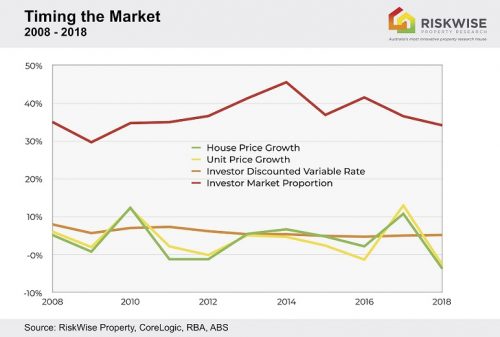Property investors are entering ‘unchartered territory’ as they can finally ‘time the market’ to their own benefit.
Melbourne, January 7: RiskWise Property Research CEO Doron Peleg described an ‘extremely unusual’ set of circumstances which meant investors could enter the market at just the right time to minimise their risk and get better capital growth.
“What property investors who want to minimise the risk need to do is:

- firstly, wait for the results of the federal election,
- secondly, wait for a formal announcement on the implementation of changes to negative gearing and capital gains tax given the odds are in favour of Labor winning and,
- thirdly, wait until these changes are fully implemented, which will probably be in 2020,” Mr Peleg said.
“Then it is just a matter of waiting out the continuous price reductions that will occur due to their implementation.
“Basically, it’s about waiting for the dust to settle and for the price reductions to stop or decelerate significantly and only then to start looking around to invest”, according to Mr Peleg.
He described “NOW” as a very unique situation because there is effective notification well in advance regarding those changes to negative gearing and capital gains tax that will increase the out-of-pocket expenses for investors and, therefore, are equivalent to a significant interest rate increase.
The Risks & Opportunities Report by RiskWise released in June last year assessed that the changes would equate to a sudden 1.15 per cent interest rate increase for investors in the Sydney unit market.
The ALP has proposed limiting negative gearing to new housing and reducing the discount on capital gains tax from the current 50 per cent to 25 per cent, however RiskWise research shows a blanket introduction of the reforms across Australia would have unintended consequences.
“It is absolutely proven that a capital growth strategy is significantly superior than a cash flow one and investors simply need to wait to get the best prices they can after the implementation of the changes,” Mr Peleg said.
He warns that if investors buy prior to the changes, their asset will depreciate as a result of the creation of primary and secondary markets.
For investors who look for capital growth, Mr Peleg points towards an investment strategy that does not place any reliance on the current taxation benefits.
“Especially as, if there is a need to refinance or an unexpected need to sell, this is highly likely to result in a loss”, Mr Peleg said.
“To minimise the risk, they need to time the market.”
Mr Peleg said the situation was “extremely unusual” because since the previous changes to negative gearing in the 1980s there hadn’t been any similar event which, in a single shot, made major increase to out-of-pocket expenses.
He said other increases to out-of-pocket expenses were largely based around gradual interest rate increases of 0.25 per cent by the RBA or out-of-cycle increases to discounted interest rates, which were gradual and relatively low.

“You certainly don’t see an announcement well in advance with a high level of certainty that the rates would go up by a full 1 per cent, on a specific date, within a year,” he said.
“It is also very unusual to make such changes to out-of-pocket expenses in the current market environment” – with credit restrictions, Banking Royal Commission outcome, a large supply of units, weak property market, limitations on borrowing against self-managed super funds … it’s a never before scenario.
Mr Peleg refers to “the good old days” when the perception was that property prices could only go up.
“But the majority of buyers have only one property which means most of the audience of ‘investors’ are people who do not have an investment property.
“So, for them to take the plunge and buy one is a major decision because, generally, in order to provide a deposit they need to refinance their primary place of residence or take money from an offset account, savings or both”.
And thus, this decision cannot be taken lightly.
To be able to reduce the risk and to time the market, investors need to wait until the market stabilises, following the implementation of the taxation changes.
“Until then investor activity is highly likely to remain low.”
Mr Peleg added currently there remained a small number of areas that were still attractive to investors across the country, particularly in south-east Queensland and regional Victoria, however, with the continued weakness in the property market their numbers were shrinking.
Nidhi Mehta
feature image: @2018 IDEA HOUSE, Austin – Photographer: Hector M Sanchez Architect: Chris Sanders Builder: Catherine and David Wilks Interior Designer: Meredith Ellis

